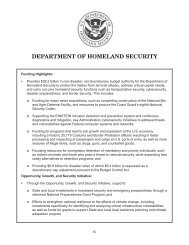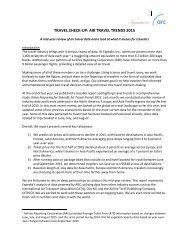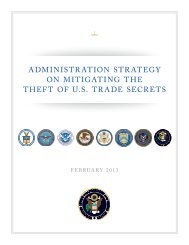A-HRC-13-42
You also want an ePaper? Increase the reach of your titles
YUMPU automatically turns print PDFs into web optimized ePapers that Google loves.
A/<strong>HRC</strong>/<strong>13</strong>/<strong>42</strong><br />
page 38<br />
81. In Nepal, a number of suspected members of the Maoist Communist Party, which had<br />
declared a “people’s war” in February 1996, were held in secret detention. 128 In the late 1990s,<br />
the increasing pattern of disappearances and secret detentions was communicated to the Working<br />
Group on Enforced or Involuntary Disappearances by numerous non-governmental<br />
organizations. It was reported that police officers in civilian clothes were forcing people into<br />
vehicles and taking them to unofficial places of detentions, such as the Maharajgunj Police<br />
Training Centre. 129<br />
82. In Sri Lanka, the protracted conflict between the Government and the Liberation Tigers of<br />
Tamil Eelam (LTTE) has perpetuated the use of secret detention. <strong>13</strong>0 In general, Sri Lankan army<br />
officials, dressed either in military uniform or civilian clothes, would arrest ethnic Tamils and<br />
hold them in secret places of detention for a week or longer. One such location mentioned in the<br />
report of the Special Rapporteur on torture was an army camp located off Galle Road,<br />
Kollupitiya, Colombo. The detainees were often interrogated under torture, the purpose of which<br />
was to make them confess their involvement with the LTTE. <strong>13</strong>1 In 1992, the Government adopted<br />
a law giving more power to the armed forces and authorizing the use of secret detention<br />
camps. <strong>13</strong>2 Although the emergency regulations subsequently issued in June 1993 outlawed secret<br />
detention, there were reliable reports indicating that people continued to be held in undisclosed<br />
places where torture was practised, and no action was taken against the perpetrators. <strong>13</strong>3<br />
83. In the Philippines, the practice of secret detention or “safe houses” was not formally<br />
banned until the establishment of the Presidential Committee in 1986. <strong>13</strong>4 These practices were<br />
not uncommon in the preceding years during the presidency of Ferdinand Marcos, especially<br />
when martial law was in force.<br />
5. Secret detention in Europe<br />
84. In Cyprus, enforced disappearances occurred during the inter-communal clashes<br />
of 1963/64 and the military intervention of 1974. Enforced disappearance as a phenomenon<br />
128 See, inter alia, the report of the Working Group on Arbitrary Detention, opinion No. 5/2001<br />
(E/CN.4/2002/77/Add.1).<br />
129 E/CN.4/2001/68.<br />
<strong>13</strong>0 E/CN.4/1992/18/Add.1.<br />
<strong>13</strong>1<br />
E/CN.4/1995/34, paras. 668-673.<br />
<strong>13</strong>2 Tulio Scovazzi and Gabriella Citroni, The Struggle against Enforced Disappearance and the<br />
2007 United Nations Convention, Leiden, Boston, Martinus Nijhoff Publishers, 2007, p. 69.<br />
<strong>13</strong>3<br />
Statement by Mr. Bhagwati, Human Rights Committee, fifty-fourth session, summary record<br />
of the 1436th meeting (CCPR/C/SR.1436).<br />
<strong>13</strong>4 Report of the Special Rapporteur on torture (E/CN.4/1987/<strong>13</strong>). See also the report of the<br />
Working Group on Enforced or Involuntary Disappearances (E/CN.4/1987/15), para. 77.
















